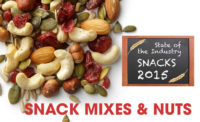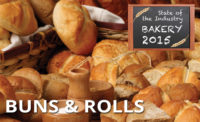While it’s undeniable that consumer demand for healthier products is shaping trends in the food industry as a whole, there’s perhaps no category affected as much as the bar category. And experts say there are many reasons why.
Overview | Bread | Tortillas | Sweet Goods | Snack Cakes | Pizza | Desserts | Cookies | Buns & Rolls | Bars
First and foremost, consumers are snacking more than ever, says Molly Spence, director, North America, Almond Board of California, Modesto, CA, to the tune of “an average of 2.3 times a day in late 2013, up from 1.8 times a day in 2008, according to our own research.”
And bars, like other convenience foods, allow today’s busy consumer to snack on the run. But because of increased public awareness of the role food plays in overall health and nutrition, consumers aren’t exactly reaching for candy bars when they need an on-the-go snack. Instead, a sort of perfect storm is brewing in which consumers are looking for convenience as well as nutrition from their snacks—two trends the bar category is addressing extremely well.
Market data
In the 52 weeks ending April 19, 2015, the bar category experienced total sales of about $4.8 billion, according to IRI, Chicago. Of those sales, a significant amount—$2.14 billion, nearly 45 percent—was attributed to bars with nutritional or other intrinsic health value. In comparison, sales of breakfast/cereal bars clocked in at about half that, making up just 22 percent of the market share with just slightly more than $1 billion in sales. When it comes down to it, the nutritional bars segment is essentially carrying the category’s overall success, as it’s the only segment that experienced an increase in sales; while sales of nutritional bars increased 8.63 percent over the previous year, sales of granola bars and breakfast bars dropped 1.34 percent and 3.92 percent, respectively.
“Consumers are becoming increasingly educated about health, wellness and the choices they’re making,” says Darian Alioto, vice president of sales, GoMacro, Viola, WI. “Their expectations are increasing as a result of their increased knowledge.”
Indeed, this is reflected in data from Mintel, which shows that roughly 42 percent of bar launches in 2014 carried low/no/reduced sugar claims, 34 percent carried high or added fiber claims, and 18 percent carried no additives or preservatives claims. Thanks to the bars market, consumers don’t need to sacrifice nutrition for convenience and, in fact, they are demanding both. The most-successful brands understand that when it comes to bars, health is the biggest trends driver.
“Talking specifically about the lifestyle and wellness segment, consumers are looking for healthy, real-food alternatives in their bar choices,” says Brianne Arnott, brand manager, Taste of Nature Foods Inc., Markham, Ontario. “You’ll notice many brands are moving toward bars made of whole ingredients, using limited sugar and preservatives to offer a quick, healthy, portable option.”
Looking back
If bar manufacturers’ target is educated bar consumers looking for healthy labels, a simple natural claim just isn’t going to cut it. This audience scrutinizes labels, looking for nutrition facts, as well as third-party certifications. “According to Almond Board of California consumer research, the latest trends indicate that consumers are looking at bars not only as a snack or meal replacement, but as a source of nutrition, as well,” says Spence. In fact, results of the Almond Board of California’s consumer study showed that heart health ranked in the top three attributes selected as most desirable by consumers, alongside taste and added protein.
Jeannie Swedberg, director of business development, Tree Top Inc., Selah, WA, identified whole ingredients as one avenue bar manufacturers have been taking to up their health ante. “Using fruit ingredients allows manufacturers to add natural ingredient claims on-pack, and also easily add a fruit serving claim, which resonates well with 26 percent of U.S. users who specifically look for bars made with natural ingredients,” she explains.
Sugar types and levels have emerged again as a new consumer focus, notes Andrew Aussie, president and founder, Earnest Eats, Solana Beach, CA—but in new ways. “Both the level of sugar in grams and the kind of sugar used is shifting,” he says, “as consumers are looking for good taste, but feeling better about how they think sugar affects health.” Specifically, this translates to a trend toward sugar alternatives like coconut-based sugars, as well as noncaloric fruit-derived sweetener options like monk fruit and lucuma appearing in bars “with varying levels of success,” he says.
In parallel, trends surrounding fats are also shifting, Aussie says, as consumers demand bars made with healthy fats like nut butters and coconut oil. He notes that the Earnest Eats Energy Bars line uses almond butter as its fat source—and that consumers are recognizing that healthy fats are an important part of a balanced diet. “It’s good to see a more-rational approach to fats in general, as the old ‘no fat is good fat’ view led to a lot of poor-tasting snacks with health compromises,” he says. “Healthy fats not only provide energy, but they’re also good appetite moderators that digest more slowly and keep you full longer, while also providing key nutrients the body needs.”
Of course, demands for healthy food labels go hand-in-hand with demands for diet-specific certifications like GMO-free, organic, gluten-free, vegan and more, and the bar category is no exception.
Lots of companies are stepping up to the plate. Taste of Nature Foods launched apple- and coconut-flavored bars in March, each boasting gluten-free, organic, non-GMO, kosher and vegan certifications.
GoMacro launched a new line of nutrition and wellness bars called Thrive, each including ingredients known to support digestive health, heart health and cognitive wellness. They’re organic, soy-free, dairy-free, gluten-free, non-GMO and vegan.
In March, Clif Bar & Co., Emeryville, CA, launched a new Organic Trail Mix Bar, featuring fruits and nuts and carrying a gluten-free label. Varieties include Dark Chocolate Almond Sea Salt, Dark Chocolate Cherry Almond, Dark Chocolate Peanut Butter and Dark Chocolate Pomegranate Raspberry.
“Not only is demand increasing for nutritious and organic food with recognizable ingredients,” says Michelle Ferguson, executive vice president of marketing, Clif Bar, “but also more consumers are now seeking food that fits within their dietary restrictions, like gluten-free bars.” To that end, the company recently transitioned its LUNA Bar to gluten-free across all flavors.
And we can expect to continue to see gluten-free surface as a top product attribute in new bar applications moving forward—often in highly flavor-forward profiles.
Looking forward
The chocolate chip granola bar has unequivocally been dethroned, as brands seek to continually up their flavor game with new and unique variations. Sweet-and-salty flavor profiles will continue to gain traction, and savory is also showing promise. GoMacro’s Thrive line boasts such varieties as Ginger Lemon, Blueberry Lavender and Curry Apricot. The KIND, LLC Strong & KIND bars come in flavors like Roasted Jalapeño, Hickory Smoked, Honey Smoked BBQ, Thai Sweet Chili and Honey Mustard.
On the delivery front, bars are taking a turn for the mini, as manufacturers bring down serving sizes. This June, Earnest Eats launched Earnest Eats Energized Bites, individually wrapped, single-serve balls that deliver energy via coconut oil, superfood grains and coffee fruit, made from the dried pulp of fruit that surrounds the coffee bean. They are available in three flavors: Trail Mix, Cherry Almond, and Mocha Nut.
Also tapping into this trend, PROBAR LLC, Salt Lake City, introduced PROBAR Bite last October. The new snack bars have 190 calories with 6 grams of protein and 3-4 grams of fiber each. They’re organic, gluten-free, dairy-free (vegan), kosher, soy-free and non-GMO. “Having all these certifications and characteristics makes the bar approachable and consumable to most consumers,” says Lambert. It comes in six varieties: Chocolate Cherry Cashew, Coconut Almond, Mixed Berry, Peanut Butter Chocolate, Peanut Butter Crunch and Superfruit + Greens.
The Gluten Free Bar has also gone bite-sized with The Gluten Free Bar Bites in Coconut Cashew Crunch, Dark Chocolate Coconut, Chocolate Cherry Almond, PB&J, Blueberry Almond Crunch, and Chocolate Hazelnut. The Bar Bites are made with a “complete protein blend” that features brown rice protein and pea protein. They’re sold in a resealable, stand-up pouch package.
As consumers continue to move toward easy solutions for calorie and portion control—along with the convenience of resealable packaging—expect to see more bite-sized, pouch-packed bar bites surface.
Whether it’s new flavors, convenient delivery, enhanced nutritional profiles or dietary certifications, the bar category is emerging as a microcosm of what consumers want on a grand scale. Going forward, the most-successful companies will effectively isolate those demands and pack them into delicious, convenient bar form.
“Since it’s a sizeable market that continues to grow, we see further product segmentation based upon lifestyle preferences taking shape in stores, to better address the needs of consumers in a very crowded space,” Alioto says. “Manufacturers will need to better understand their consumers and their needs more than ever since the space is filled with new brands entering every year.”
The brands and companies with the best strategy, and the ability to keenly understand what consumers want, should continue to emerge as the leaders.
Overview | Bread | Tortillas | Sweet Goods | Snack Cakes | Pizza | Desserts | Cookies | Buns & Rolls | Bars
















